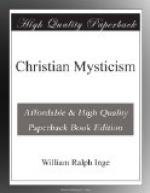[Footnote 327: In the case of irregular Baptism, the maxim holds: “Fieri non debuit; factum valet.” Cf. Bp. Churton, The Missionary’s Foundation of Doctrine, p. 129. The reason for this difference between the two sacraments is quite clear.]
[Footnote 328: It is, of course, difficult to decide how far such statements were meant to be taken literally. But there is no doubt that both Baptism and the Eucharist were supposed to confer immortality. Cf. Tert. de Bapt. 2 (621, Oehl.), “nonne mirandum est lavacro dilui mortem?”; Gregory of Nyssa, Or. cat. magn. 35, [Greek: me dynasthai de phemi dicha tes kata to loutron anagenneseos en anastasei genesthai ton anthropon]. Basil, too, calls Baptism [Greek: dynamis eis ten anastasin]. Of the Eucharist, Ignatius uses the phrase quoted, [Greek: pharmakon tes athanasias], and [Greek: antidotos tou me apothanein]; and Gregory of Nyssa uses the same language as about Baptism. See, further, in Appendices B and C.]
[Footnote 329: E.g. [Greek: metallaxis] (Theodoret), [Greek: metabole] (Cyril), [Greek: metapoiesis] (Gregory Naz.), [Greek: metastoicheiosis] (Theophylact). The last-named goes on to say that “we are in the same way transelementated into Christ.” The Christian Neoplatonists naturally regard the sacrament as symbolic. Origen is inclined to hold that every action should be sacramental, and that material symbols, such as bread and wine, and participation in a ceremonial, cannot be necessary vehicles of spiritual grace; this is in accordance with the excessive idealism and intellectualism of his system. Dionysius calls the elements [Greek: symbola, eikones, antitypa, aistheta tina anti noeton metalambanomena]; and Maximus, his commentator, defines a symbol as [Greek: aistheton ti anti noetou metalambanomenon].]
[Footnote 330: Harnack (History of Dogma, vol. vi. p. 102, English edition) says: “In the centuries before the Reformation, a growing value was attached not only to the sacraments, but to crosses, amulets, relics, holy places, etc. As long as what the soul seeks is not the rock of assurance, but means for inciting to piety, it will create for itself a thousand holy things. It is therefore an extremely superficial view that regards the most inward Mysticism and the service of idols as contradictory. The opposite view, rather, is correct.” I have seldom found myself able to agree with this writer’s judgments upon Mysticism; and this one is no exception. The “most inward Mysticism” does not occupy itself much with external “incitements to piety,” nor is this the motive with which a mystic could ever (e.g.) receive the Eucharist. The use of amulets, etc., which Harnack finds to have been spreading before the Reformation, and which was certainly very prevalent in the sixteenth and seventeenth centuries, had very little to do with “the most inward Mysticism.” My view




